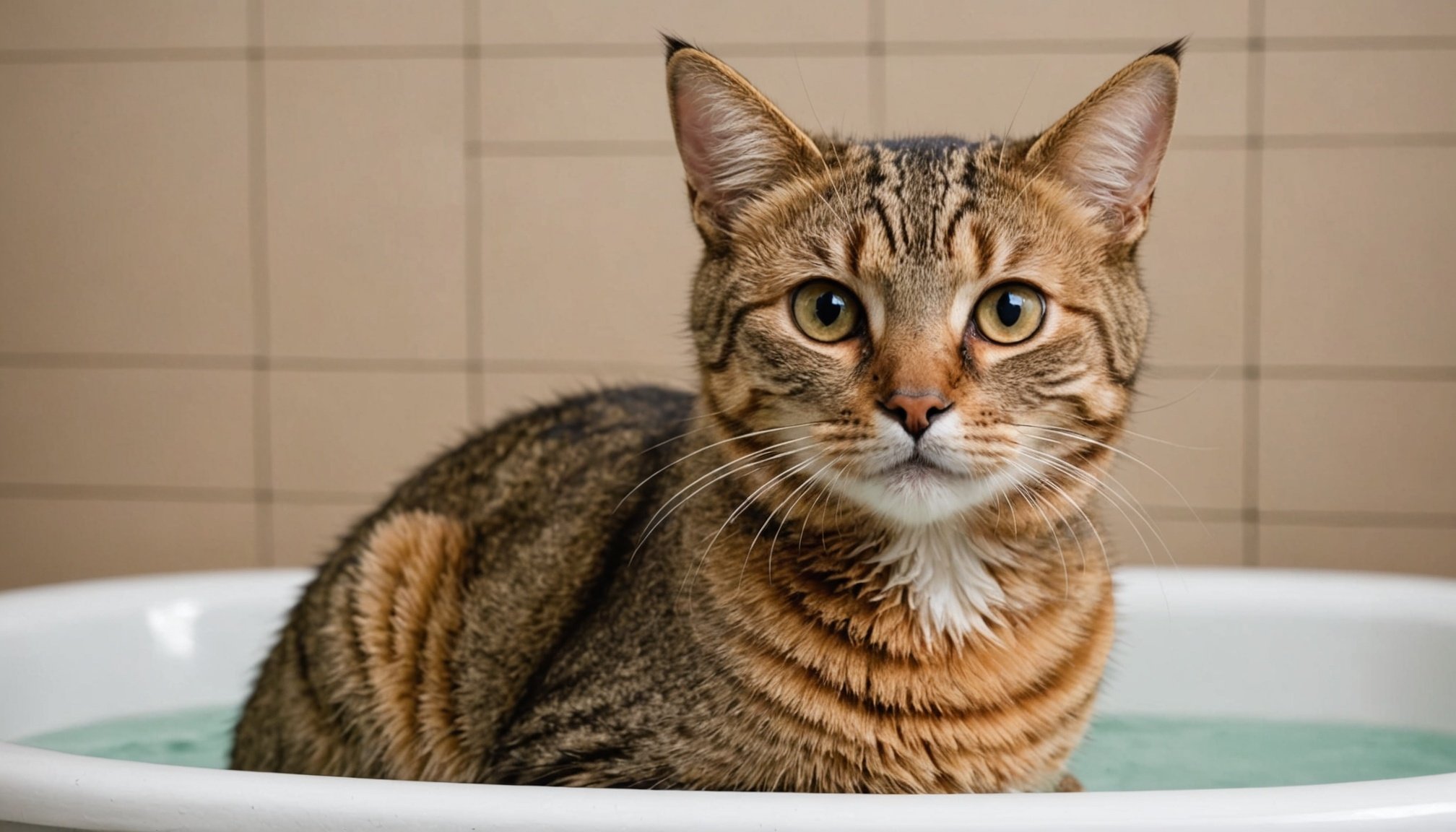Essential Guide to Bathing Cats: Techniques for Managing Medical Conditions and Skin Problems
Bathing your cat can be a daunting task, but it is sometimes necessary, especially when dealing with medical conditions or skin problems. Here’s a comprehensive guide to help you navigate the process safely and effectively.
Understanding When Your Cat Needs a Bath
Before we dive into the how, it’s crucial to understand when your cat actually needs a bath. Most cats are meticulous about their grooming and spend a significant amount of time cleaning themselves. However, there are instances where your cat might require your assistance.
This might interest you : What signs indicate that my cat is experiencing stress or anxiety?
- Medical Reasons: If your vet advises you to bathe your cat due to a skin condition, allergy, or infection, it is essential to follow their instructions carefully. For example, hairless cats need regular baths to keep their skin clean and free of oils.
- Exposure to Substances: If your cat gets something sticky, nasty, or toxic on their coat, a bath may be necessary to ensure their health and safety.
- Hygiene: Cats that are unable to groom themselves properly, such as older or disabled cats, may need regular baths to maintain their hygiene and prevent skin issues.
Preparing Your Cat for Bath Time
Preparing your cat for the bathing process is key to making it as stress-free as possible for both you and your pet.
Getting Your Cat Used to the Bathing Process
“Get your cat used to the sights, sounds, and smells associated with the bathing process,” advises Dr. Bernadine Cruz, a veterinarian. This can be done by letting your cat explore the bathroom or kitchen where the bath will take place. Allow them to sniff and get comfortable with the bathing area, the sound of running water, and the smell of the shampoo.
Also to see : How do I choose the right type of scratching surface for my cat’s specific needs?
Choosing the Right Time
Timing is everything when it comes to bathing your cat. For younger cats, consider bathing them after a vigorous playtime session when they are tired. For older cats, it might be better to bathe them after they wake up from a nap, ensuring they are calm and less energetic.
Using the Right Equipment
- Cat Harness: A cat harness with a leash attached to a sturdy hook can help you control your cat’s movements and free your hands to bathe and comfort them.
- Non-Slip Mat: Ensure the bathing area has a non-slip mat to provide your cat with a sense of security and prevent slipping.
- Warm Water: Use warm water, but not too hot or cold. The ideal water level should be no higher than the halfway point between the paw and elbow area.
The Bathing Process
Bathing your cat requires careful attention to detail and a gentle approach.
Drawing the Bath
- Location: The kitchen sink is often a better option than a bathtub because it is smaller and cozier for the cat, and easier on your back.
- Water Temperature: Make sure the water is warmer than a baby’s bath temperature but not too deep.
- Shampoo: Use a gentle, cat-friendly shampoo. Human shampoo is too harsh for cats and can cause skin irritation.
Bathing Your Cat
- Support: If you don’t have a cat harness, use one hand to support your cat and the other to bathe. Start from the neck down to avoid getting water in the ears or eyes.
- Face Cleaning: Use a washcloth to clean the face gently.
- Rinsing: Use a hand-held faucet attachment or a plastic pitcher to rinse your cat. Some cats may prefer the gentle stream of a pitcher over the faucet.
After Bath Care
After the bath, it’s crucial to dry your cat thoroughly and provide them with the necessary care.
Drying Your Cat
- Towel Drying: Wrap your cat in a soft, warm towel to dry them. This can help win back their good graces after the bath.
- Blow Drying: If you’re feeling confident, you can use a blow dryer on a quiet and low setting. However, be cautious as some cats may find this too stressful.
Brushing
Brushing is especially important for longer-haired cats to prevent matting and tangling. Brushing before and after the bath helps loosen the hair and prevents additional hairballs and vomiting.
### Key Steps for After Bath Care
- **Dry Thoroughly**: Use a soft, warm towel to dry your cat.
- **Brush Gently**: Brush your cat to prevent matting and tangling.
- **Check for Health Issues**: Look for any lumps, bumps, or signs of illness during the brushing process.
- **Provide Comfort**: Keep your cat in a warm, draft-free area to help them relax after the bath.
Managing Skin Conditions and Medical Issues
When dealing with skin conditions or medical issues, bathing your cat requires extra care and attention.
Common Skin Conditions
- Allergies: If your cat has allergies, they may need regular baths with a specific shampoo prescribed by your vet.
- Infections: Skin infections may require antibacterial shampoos and careful monitoring.
- Eczema: Eczema in cats can be managed with medicated shampoos and regular grooming.
Using Prescription Shampoos
If your vet prescribes a specific shampoo for your cat’s skin condition, make sure to follow the instructions carefully.
### Tips for Using Prescription Shampoos
- **Follow Instructions**: Use the shampoo exactly as prescribed by your vet.
- **Avoid Over-Bathing**: Only bathe your cat as frequently as recommended to avoid drying out their skin.
- **Monitor Progress**: Keep an eye on your cat’s skin condition and report any changes to your vet.
- **Combine with Other Treatments**: If your vet recommends other treatments, such as topical creams or oral medications, ensure you use them in conjunction with the shampoo.
Table: Comparing Different Types of Shampoos for Cats
| Type of Shampoo | Description | Use Cases |
|---|---|---|
| General Cat Shampoo | Gentle, non-irritating shampoo for regular use. | Healthy cats needing occasional baths. |
| Medicated Shampoo | Contains ingredients to treat skin conditions like allergies, infections, or eczema. | Cats with specific skin conditions as prescribed by a vet. |
| Hypoallergenic Shampoo | Designed for cats with sensitive skin to minimize allergic reactions. | Cats with skin sensitivities or allergies. |
| Flea and Tick Shampoo | Contains ingredients to kill fleas and ticks. | Cats with flea or tick infestations. |
| Oatmeal Shampoo | Soothing shampoo for irritated skin. | Cats with skin irritations or itching. |
Practical Insights and Actionable Advice
Bathing your cat is not just about the bath itself but also about the overall care and health of your pet.
Regular Grooming
Regular grooming is essential for maintaining your cat’s health and preventing matting and tangling of their fur.
### Benefits of Regular Grooming
- **Prevents Matting**: Regular brushing prevents matting and tangling, especially in long-haired cats.
- **Reduces Hairballs**: Brushing helps reduce the amount of hair your cat swallows, leading to fewer hairballs.
- **Distributes Natural Oils**: Brushing distributes natural oils through the coat, contributing to a healthier coat and skin.
- **Bonding Experience**: Grooming is a great way to bond with your cat and check for any health issues.
Choosing the Right Food
The food your cat eats can also impact their skin health. Here are some tips for choosing the right food:
### Tips for Choosing the Right Food
- **Consult Your Vet**: If your cat has skin conditions or allergies, consult your vet for recommendations on the best food.
- **Look for Hypoallergenic Options**: Foods with novel protein sources (like venison or salmon) and unique carbohydrates (like potato or green pea) can be beneficial for cats with allergies.
- **Avoid Fillers**: Choose foods with whole ingredients and avoid fillers that can exacerbate skin issues.
- **Consider Prescription Diets**: If your vet recommends a prescription diet, follow their advice to help manage your cat’s skin condition.
Bathing your cat, especially when dealing with medical conditions or skin problems, requires patience, care, and the right techniques. By understanding when your cat needs a bath, preparing them properly, and using the right equipment and shampoos, you can make the experience less stressful for both you and your pet. Remember, regular grooming and the right diet are also crucial for maintaining your cat’s overall health and well-being.
In the words of Dr. Bernadine Cruz, “Fur is fabulous for hiding a myriad of issues. Anything out of the ordinary should be brought to your veterinarian’s attention.” Always consult with your vet before making any significant changes to your cat’s care routine.






